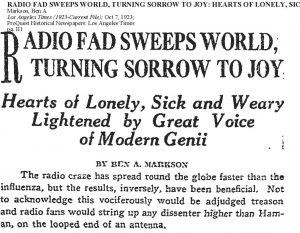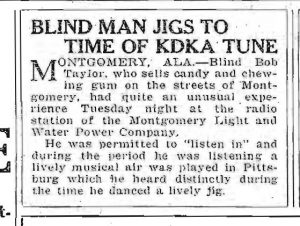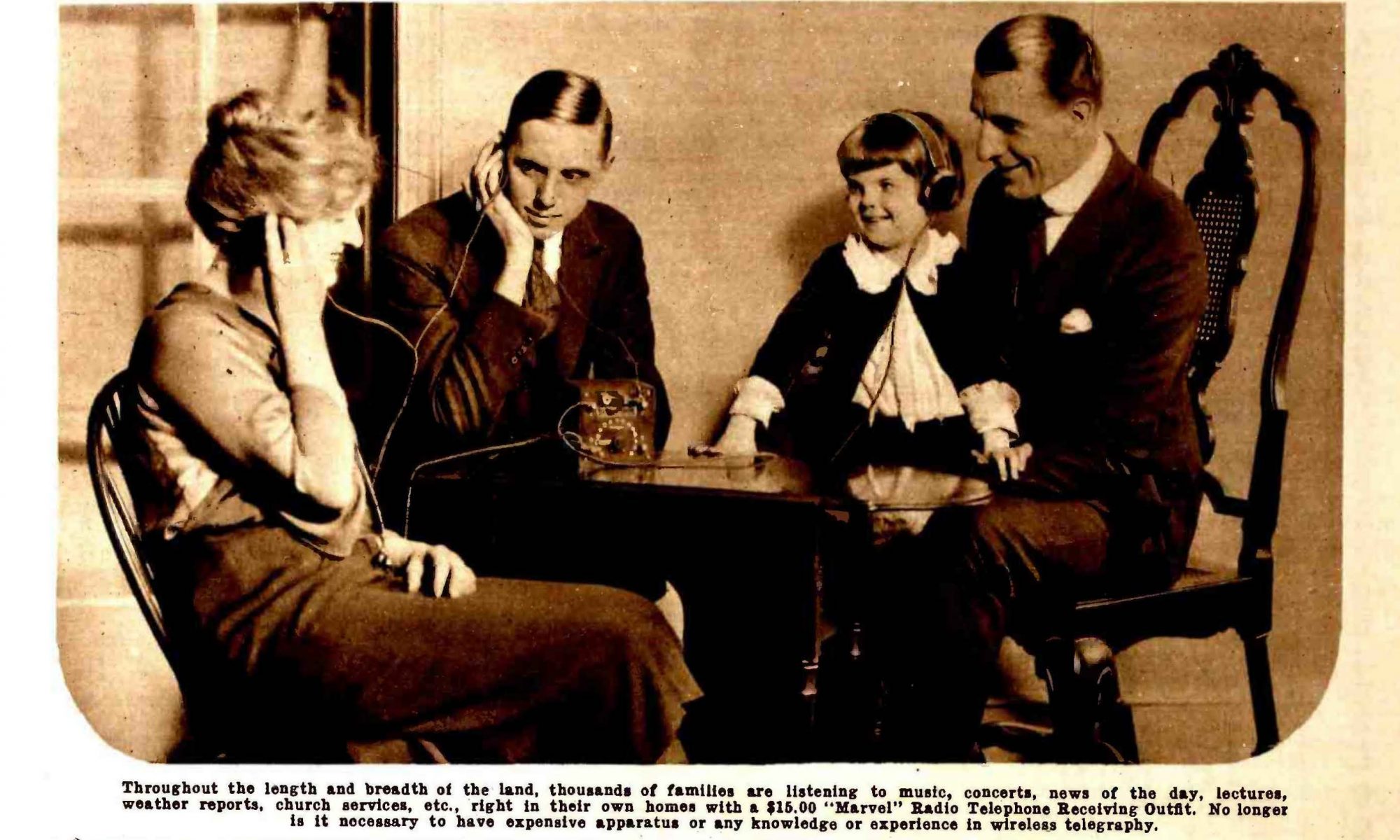The Promise of Radio: New Media in San Diego and Los Angeles
The discourse related to radio in magazines and in newspapers in the early 1920s promised great things. The Los Angeles Times, Los Angeles Examiner, San Diego Sun, San Diego Union, and San Diego Tribune newspapers advanced the themes of unification, better communication, advancement of education, ending isolation, and open access to religion to promote their radio stations as a public service put in place to better their listeners’ and readers’ lives.

Newspapers associated with radio stations in Los Angeles and San Diego mirrored the national pattern in their promotion of the unifying power of radio. In his 1924 article “The Social Destiny of Radio”, Waldemar Kaempffert extolled the unifying force of radio. He envisioned a time when radio would be a “super radio university educating the world.”[1] In his view, radio would not only unify the United States, but would make English the lingua franca of the world. Kaempffert commended radio for “achieving the task of making us feel together, think together, live together.” [2] The Outlook magazine article “Radio – The New Social Force” illustrated how radio was described as “the salvation of democracy” and “a means for general and perpetual peace on Earth”.[3] The Los Angeles Examiner when it announced its new station promised that it would bring the “voice of the great city” to far off listeners in the desert and the mountains. The Los Angeles Examiner proposed that this would join these households “with the whole world from which they have been so long set apart.”[4] The San Diego Sun extolled how radio would allow listeners to hear programs around the world because “radio messages can be heard anywhere on the earth, in the air, under the ocean.”[5] The Los Angeles Times sponsored a radio listener club in its radio columns months before the KHJ radio station started to broadcast. Through the sponsorship of this club, the newspaper promoted the idea of a radio listener community.[6] C. M. Ripley stated in the Los Angeles Times in 1924, “If there ever was a cosmopolitan audience in the history of the world, the invisible audience of radio is one.” Ripley commented that audiences prior to radio had all been from the same community and cultural background. Radio had created an audience from many different communities and socio-economic classes.[7]
Ever since KDKA’s broadcasting of the 1920 election results, national and southern California publications had promised that radio would provide uncensored communication. In the inaugural issue (May 1922) of Radio Broadcast magazine, Dr. Alfred Goldsmith described radio’s benefits as a communication device that can bring greater understanding between people.[8] He explained that radio could end isolation and could enable people to become more involved in government policies and procedures. He also  described how radio could lead to better political and economic communication between nations. Bruce Bliven in his 1924 article “How Radio is Remaking Our World” stated that he felt that radio would have a “serious influence on our national political life”.[9] The Los Angeles Times station regularly broadcast speeches from state, and federal officials.[10] In an article published in July 1924, the Los Angeles Times noted that radio would change presidential campaigns because the “pitiless publicity” of radio broadcasts meant that listeners could listen to every word of the speeches.[11] Kaempffert in his article postulated that citizens would have a better chance judging the argument of politicians if they could hear it directly.[12]
described how radio could lead to better political and economic communication between nations. Bruce Bliven in his 1924 article “How Radio is Remaking Our World” stated that he felt that radio would have a “serious influence on our national political life”.[9] The Los Angeles Times station regularly broadcast speeches from state, and federal officials.[10] In an article published in July 1924, the Los Angeles Times noted that radio would change presidential campaigns because the “pitiless publicity” of radio broadcasts meant that listeners could listen to every word of the speeches.[11] Kaempffert in his article postulated that citizens would have a better chance judging the argument of politicians if they could hear it directly.[12]
The promise of radio to provide free education and culture through free university courses and cultural programming was widely publicized in the national and southern California based radio magazines and the newspapers. In the May 1922 issue of Radio Broadcast, J. H. Morecroft describes a radio experiment where Columbia University created a series of ten minute talks on the works of Robert Browning.[13] Morecroft stated that listeners were being educated “as a result of the excellent musical programs being broadcasted nowadays by the better class of stations, but it remains to be seen whether people will actually pay for educational programming”.[14] Bliven envisioned universities “giving radio course in every conceivable subject.”[15] A May 1922 Literary Digest article described college courses being broadcast within college classrooms and throughout the nation. Declaring that “every radio home within a thousand miles of Los Angeles will be a college in the near future”, the Los Angeles Examiner announced a series of daily lectures from different branches of science given by the colleges and universities in the Southern California area.[16] The San Diego Evening Tribune sponsored lectures from the local postmaster about the proper way to mail packages and letters.[17] The Los Angeles Times promised to offer “educational matter of a highly profitable order” when they announced the opening of their new broadcast station in Oct 1922.[18] The newspapers often overplayed the amount of educational programming that they broadcast. A look at weeks’ worth of programs in July of 1922 for the Los Angeles Times’ station KHJ showed that they broadcast a mix of popular music, instrumental music, whistlers, operatic singing, lectures, news, and children’s programming. There were sermons and hymns on Sunday.[19] A look at the broadcast schedules for the Los Angeles Times and Los Angeles Examiner in the August 1923 Radio Doings magazine, however, shows that the programming was mainly orchestral and operatic in nature with some children’s programming and news.[20] Historian Susan Douglas noted that this type of “salon” programming was popular because it reflected radio station’s goals of being seen as a respectable medium and as “culturally uplifting and proper.”[21]

Farmers in the Los Angeles and San Diego areas used radio to learn about possible adverse weather conditions and to coordinate bringing crops to market. In February of 1924, the Los Angeles Times described how a transport company used radio to coordinate and improve the efficiency of the harvest and transport of vegetables from the San Luis Rey Valley in northern San Diego County to market in Los Angeles. The radio was carried on “a combination service car and ambulance” that patrolled the San Diego County backcountry, going from farm to farm to see what the farmers needed to get to market. The service car would then call San Diego to arrange for a truck to come to transport the crops. [22] The Orchard Heating Department of the American Can Company sponsored programming on KHJ in 1924. During their sponsored program, the Orchard Heating Department would give frost warnings to local citrus farmers so they could better use their smudge pots to keep their crop from freezing.[23]
The newspapers also promoted how radio could help alleviate the isolation of the blind and the infirm. The Radio Broadcast magazine in their June 1923 issue described how radio receivers in a veteran’s hospital helped alleviate the tedium of the patients, noting that they regularly listen to KHJ and KFI.[24] The Los Angeles Times gave radio sets to “patients in hospitals and inmate of  charitable and other homes” so that they could have “world activities brought to them” through KHJ broadcasts.[25] The San Diego Sun illustrated how radio was a technology accessible to the blind by including a picture of an unidentified man with the caption “Blind Radio Fan is Best in State.”[26] In October of 1923, write Ben Markson praised the ability of KHJ to help invalids, shut-ins, the blind, and the aged. He gushed, “Borne on the wings of kindness and unselfishness, there is a broadcast from KHJ a never-ending message of cheer and goodwill.”[27]
charitable and other homes” so that they could have “world activities brought to them” through KHJ broadcasts.[25] The San Diego Sun illustrated how radio was a technology accessible to the blind by including a picture of an unidentified man with the caption “Blind Radio Fan is Best in State.”[26] In October of 1923, write Ben Markson praised the ability of KHJ to help invalids, shut-ins, the blind, and the aged. He gushed, “Borne on the wings of kindness and unselfishness, there is a broadcast from KHJ a never-ending message of cheer and goodwill.”[27]
Sources for Page
[1] Waldemar Kaempffert. “The Social Destiny of Radio.” Forum, no. 71 (1924): 768.
[2] Kaempffert. “The Social Destiny of Radio,” 772.
[3] “Radio – The New Social Force.” The Outlook, March 19,1924, 466.
[5] “Daily News Flashes to be Broadcasted.” Los Angeles Examiner, Apr 15, 1922; “Radio’s Uses Unlimited.” San Diego Sun, March 30, 1922.
[6] “Radio Fans, Attention!” Los Angeles Times , Mar 28, 1922.
[7] C. M. Ripley. “World Drawn Close by Radio.” Los Angeles Times, May 25, 1924.
[8] Edgar H. Felix. “Dr. Alfred N. Goldsmith on the Future of Radio Telephony.” Radio Broadcast, May 1922, 44.
[9] Bruce Bliven. “How Radio is Remaking Our World.” Century Magazine, June 1924,149.
[11] “Davis Speech Broadcast.” Los Angeles Times (1886-1922), Nov 12, 1922; “The Times – KHJ – On the Air Today.” Los Angeles Times, July 13, 1922.
[12] Kaempffert. “The Social Destiny of Radio,” 768.
[13] J. H. Morecroft. “The March of Radio: Broadcasting Browning.” Radio Broadcast, February 1924, 271-272
[14] Morecroft “The March of Radio,” 271.
[15] Bliven. “How Radio is Remaking Our World,” 150.
[16] “Lecture by Wireless.” Los Angeles Examiner, April 15,1922.
[17] “New Hours for Radio Program.” San Diego Evening Tribune, May 22, 1922.
[18] “Giagantic New ‘Times’ Radio Station Will Be Placed on Air Soon.” Los Angeles Times, October 22, 1922.
[19] I looked at program guides for the week of July 10, 1922 through July 16, 1922. KHJ was not on the air on Saturday July 15, 1922. KHJ broadcasted from 1:00 p.m. to 1:45 p.m. and 7:15 p.m. to 8:00 p.m. Monday through Friday. KHJ broadcasted the weather and crop reports from 8:00 p.m. – 8:15 on the 485 meters wavelength reserved for those reports Monday through Friday as well. KHJ broadcasted on Sundays from 10:00 a.m. – 10:45 a.m.
[20] Radio Doings, August 25, 1923. 17-21.
[21] Susan Douglas. Listening In, 86.
[22] “Radio Service for Isolated Farmers.” Los Angeles Times, February 11, 1923; The San Diego Union described this same service in less detail in January of 1923. “Radio Telephone Truck Informs Farmers Daily.” San Diego Union, Jan 14, 1923.
[23] “KHJ to Provide New Features.” Los Angeles Times, Oct 19, 1924.
[24] Radio Broadcast, June 1923, 147-148.
[25] “Ten Institutions Given ‘Times’ Radio Phones.” Los Angeles Times, March 30, 1922; “Gigantic New ‘Times’ Radio Station Will Be Placed on Air Soon.” Los Angeles Times, Oct 22, 1922; The Times mentions how these receivers have been a “boon to shut-ins” when they announced the opening of their new station in October 1922.
[26] “Blind Radio Fan is Best in State.” San Diego Sun, March 22, 1922.
[27] Ben A. Markson. “Radio Fad Sweeps World Turning Sorrow to Joy.” Los Angeles Times, Oct. 7, 1923.
